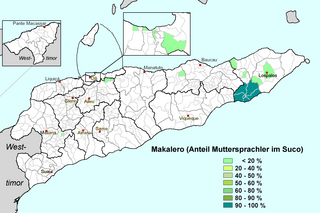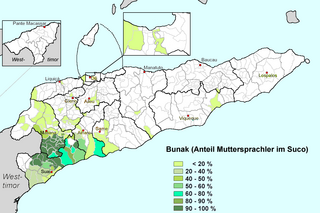
Makalero or Maklere is a Papuan language spoken in the Lautém district of East Timor. It was previously considered to be a dialect of Makasae, but is nowadays seen as a separate language, both by its speakers and linguists.

Makasae is a Papuan language spoken by about 100,000 people in the eastern part of East Timor, in the districts of Baucau and Viqueque, just to the west of Fataluku. It is the most widely spoken Papuan language west of New Guinea.

The Bunak language is the language of the Bunak people of the mountainous region of central Timor, split between the political boundary between West Timor, Indonesia, particularly in Lamaknen District and East Timor. It is one of the few on Timor which is not an Austronesian language, but rather a Papuan language of the Timor-Alor-Pantar language family. The language is surrounded by Malayo-Polynesian languages, like Uab Meto and Tetum.

The Bunak people are an ethnic group that live in the mountainous region of central Timor, split between the political boundary between West Timor, Indonesia, particularly in Lamaknen District and East Timor. Their language is one of those on Timor which is not an Austronesian language, but rather a Papuan language, belonging to the Trans–New Guinea linguistic family. They are surrounded by groups which speak Malayo-Polynesian languages, like the Atoni and the Tetum.

Western Pantar, sometimes referred to by the name of one of its dialects, Lamma, is a Papuan language spoken in the western part of Pantar island in the Alor archipelago of Indonesia. Western Pantar is spoken widely in the region by about 10,000 speakers. Although speakers often use Malay in political, religious, and educational contexts, Western Pantar remains the first language of children of the region, and is acquired to some extent by immigrants.
Nedebang is a Papuan language spoken in the villages of Balungada and Baulang in the eastern district of Pantar island in the Alor archipelago of Indonesia. There are also Nedebang speakers in Air Panas, administratively part of Balungada but located 1 km from the main village.
Abui is a non-Austronesian language of the Alor Archipelago. It is spoken in the central part of Alor Island in Eastern Indonesia, East Nusa Tenggara (NTT) province by the Abui people. The native name in the Takalelang dialect is Abui tanga which literally translates as 'mountain language'.
Adang is a Papuan language spoken on the island of Alor in Indonesia. The language is agglutinative. The Hamap dialect is sometimes treated as a separate language; on the other hand, Kabola, which is sociolinguistically distinct, is sometimes included. Adang, Hamap and Kabola are considered a dialect chain. Adang is endangered as fewer speakers raise their children in Adang, instead opting for Indonesian.

The Alor–Pantar languages are a family of clearly related Papuan languages spoken on islands of the Alor archipelago near Timor in southern Indonesia. They may be most closely related to the Papuan languages of eastern Timor, but this is not yet clear. A more distant relationship with the Trans–New Guinea languages of the Bomberai peninsula of Western New Guinea has been proposed based on pronominal evidence, but though often cited has never been firmly established.
The Timor–Alor–Pantar (TAP) languages are a family of Papuan (non-Austronesian) languages spoken in Timor, Kisar, and the Alor archipelago in Southern Indonesia.

The West Trans–New Guinea languages are a suggested linguistic linkage of Papuan languages, not well established as a group, proposed by Malcolm Ross in his 2005 classification of the Trans–New Guinea languages. Ross suspects they are an old dialect continuum, because they share numerous features that have not been traced to a single ancestor using comparative historical linguistics. The internal divisions of the languages are also unclear. William A. Foley considers the TNG identity of the Irian Highlands languages at least to be established.
Kui is a Timor–Alor–Pantar language spoken in several enclaves on Alor Island, East Nusa Tenggara, Indonesia. The language is called 'Masin lak' in Kui. Although the exact number of speakers is unknown, Kui is an endangered language since speakers are shifting to Alor Malay.
Sawila, or Tanglapui, is a Papuan language of the Alor archipelago. Dialects are Sawila proper, Lona, Salimana, Lalamana, Sileba. Sawila speakers refer to their language as Manata.
Kula (Kola) or Lamtoka (Lantoka), also known as Tanglapui, is a Papuan language spoken in villages on the north coast, south coast and mountainous interior of Alor Island in Indonesia. Dialects are Kula proper, Kulatela, Watena, Kula Watena, Iramang, Larena, Sumang, and Arumaka. Most settlements where Kula is spoken are "new villages" that have only been inhabited since the 1960s. Due to this recent resettlement, and since usage of the language is discouraged in schools, Kula is an endangered language.

Blagar is a Papuan language of Pantar island in the Alor archipelago of Indonesia. The Tereweng dialect spoken on Treweng Island off the southeast coast of Pantar is sometimes considered a separate language.
Woisika, also known as Kamang, is a Papuan language of Alor Island of Indonesia. The three main dialects are Western Kamang, Lowland Kamang, and Upland Kamang. Dialects also include Lembur, Sibo, Kamang, Tiayai, Watang, Kamana-Kamang. They may constitute more than one language. Kamang is an endangered language, since children usually only have passive competence of the language, and instead are shifting to Malay.
Kafoa, or Jafoo, is a Papuan language of Alor Island in the Alor archipelago of Indonesia. The name "Kafoa" is not recognized by speakers; it is not clear which name they use themselves. Kafoa speakers are frequently multilingual, also speaking Malay, Klon and Abui. Children are typically initially taught Malay by their parents and later acquire Kafoa after having reached school age.
Rongga is a language of central Flores, in East Nusa Tenggara Province, Indonesia. Rongga is closely related to Ngadha, and more distantly to Manggarai.
The Oirata–Makasai, or Eastern Timor, languages are a small family of Papuan languages spoken in eastern Timor and the neighboring island of Kisar.
Kaera is a Papuan language spoken on the northeastern coast of Pantar island in the Alor archipelago of Indonesia. It belongs to the Timor-Alor-Pantar language family. Kaera is used alongside Indonesian in religious contexts, but not used in education.







